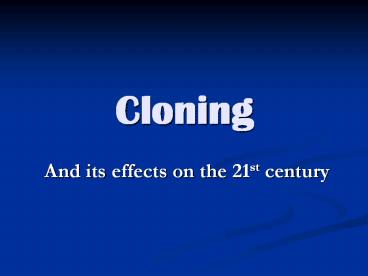Cloning PowerPoint PPT Presentation
1 / 13
Title: Cloning
1
Cloning
- And its effects on the 21st century
2
What is cloning?
- Cloning is any process natural or artificial
which produces two or more cells or organisms
that are genetically identical to one another - These cells or organisms we call clones
3
Clones
- A clone is an organism that does not begin from
sexual event, which is the fusion of genetic
material from two beings. Instead a clone is
formed asexually. - Clones start from either one, or a group of cells
from a single organism.
4
There are two types of clones
- Natural Clones
- Any cells that produce asexually
- Includes identical twins
- Artificial Clones
- Are formed when someone physically takes the DNA
from one organism and transfers it to another
organism, putting the DNA into the host cell. The
host cell then divides forming the clone.
5
There are 3 different types of cloning
- Recombinant DNA Technology
- Reproductive Cloning
- Therapeutic Cloning
6
Recombinant DNA Technology
- Also called DNA cloning, molecular cloning, and
gene cloning - DNA cloning is the process of transferring DNA
fragments from one organism to a self-replicating
genetic element - The DNA is then put into the host cell of the
genetic element
7
Reproductive Cloning
- Is the process of generating a new mammal, where
a scientist creates an exact copy of a previously
existing mammals genes, making an exact replica
of the first mammal.
8
Therapeutic Cloning
- Also called embryo cloning
- In therapeutic cloning scientists take embryos
and use them in their research - The scientists use the embryos to produce the
stem cells which they study to learn about human
development and to help treat diseases
9
Theoretical Benefits of Cloning
- Will teach us the process of mammalian
development - Would allow us to see what happens when stages of
development are altered or removed completely - Also could help us learn what sexual beginning
does for mammalian life
10
Practical Benefits of Cloning
- Cloning would help greatly for medical reasons
- -would help cure diseases
- -could allow us to replace malfunctioning organs
with a clone of that organ - -medicines and drug supplies would benefit
because we would be able to clone more of the
animals that produce certain proteins needed for
medicines, resulting in more medicines available
to people - -could help find a cure for cancer
- Cloning more of the better animals allows us to
have higher-quality, healthier meat and milk
products from our animals - Revive endangered and extinct species
11
Human Cloning
- Beneficial for
- A couple who is infertile and wants to have a
child - Could replace a child or loved one who has died
12
Cloning currently is not allowed to be done on
humans, and it does not look like it will be
aloud anywhere in the near future. Reasons for
this is because cloning is not stable yet, there
has not been enough success in cloning and
because of the arguments about the ethics behind
cloning.
13
References
(2006). Cloning fact sheet. Retrieved November
26, 2007 on the World Wide Web http//ornl.gov/s
ci/techresources/Human_Genome/elsi/cloning.shtml
Agar, Nicholas. (2002). Perfect Copy. United
Kingdom Icon Books. Gogoi, Pallovi. (2007).
Cloning scientists vs. consumers. Retrieved
November 22, 2007, from Ebsco online
http//search.ebscohost.com/login.aspx?directtr
uedbrchAN25005341sitesrc-live Levine,
Louis. (2007). Cloning. Grolier Multimedia
Encyclopedia. Retrieved November 22, 2007, from
Grolier online http//gme.grolier.com/cgibin/arti
cle?assetid0065440-0 University of Utah (2007).
Cloning in Focus. Retrieved November 22, 2007 on
the World Wide Web http//learn.genetics.utah.ed
u/units/cloning/ Yount, Lisa. (2000). Cloning.
San Diego Greenhaven Press.

